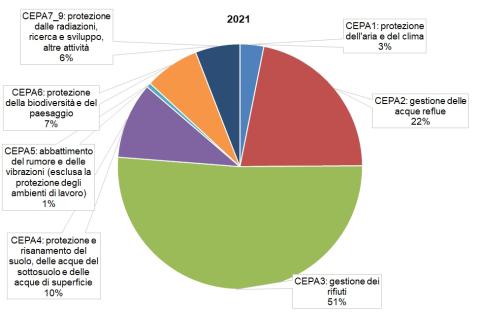ENVIRONMENTALLY BENEFICIAL SUBSIDIES AND ENVIRONMENTALLY HARMFUL SUBSIDIES
Data aggiornamento scheda:
In 2022, the sixth edition of the Catalogue of Environmentally Relevant Subsidies identified a total of 183 measures, resulting in €24.2 billion in Environmentally Harmful Subsidies (EHS) and €20.2 billion in Environmentally Beneficial Subsidies (EBS), representing a year-on-year increase of 15.1% and a decrease of 2.5%, respectively. Subsidies amounting to €13.8 billion were classified as having uncertain environmental impact, marking a 7.5% increase compared to 2021. Among the Environmentally Harmful Subsidies, those related to fossil fuels accounted for €17 billion in 2022 (compared to €13 billion in 2020 and €14.8 billion in 2021).
CIRCULAR MATERIAL USE RATE
Data aggiornamento scheda:
The circular material use rate measures the share of material resources reused by an economy. In the period 2004–2023, Italy's circular material use rate increased from 5.8% to 20.8%.
ENVIRONMENTAL TAXES
Data aggiornamento scheda:
Statistical information on environmental taxes can be broken down by tax category, the units that pay the taxes, the class of environmental activity, and the destination of the revenue. In Italy, environmental taxes amount to €60.8 billion in 2024 (+11.6% compared to the previous year). In 2024, environmental tax revenue represents about 6.1% of total taxes and social contributions (2023) and about 3% of Gross Domestic Product.
Circular economy sector: employment, added value, investments
Data aggiornamento scheda:
From 2005 to 2023, in Italy, the circular economy sector showed signs of economic strengthening, with an increase in value added (+0.4 percentage points on GDP) and investments (+0.2 points), but a decrease in relative employment (-0.2 points), highlighting the need for policies that accompany the transition with greater attention to inclusion and the social dimension of circular work.
MATERIAL FLOWS AND RESOURCE PRODUCTIVITY
Data aggiornamento scheda:
In 2024, Domestic Material Consumption in Italy stood at 486 million tonnes (-0.7% compared to 2023), while Resource Productivity grew to 3.76 euro/kg (+1.4%), confirming an improvement in the efficiency of the use of natural resources.
Material Footprint
Data aggiornamento scheda:
Italy has structurally reduced its material footprint, going from 17.9 to 10.3 tonnes per capita between 2008 and 2024, reaching values lower than the EU average. This result reflects significant progress in terms of efficiency and circularity, but it requires consolidating the decoupling between economic growth and resource consumption in order to make the competitive advantage durable.
ECO INNOVATION INDEX
Data aggiornamento scheda:
In 2024 Italy confirms itself among the EU leader countries in terms of eco-innovation, with performances above the European average in resource efficiency, energy productivity, and emissions. Between 2014 and 2024, the Italian index grew by +39.2 percentage points (pp), exceeding the EU average increase (+27.5 pp), with a particularly marked improvement in resource efficiency (+64.4 pp compared to +62 pp EU).
ECOINDUSTRIES
Data aggiornamento scheda:
The indicators derived from the Environmental Goods and Services Accounts provide information on the main economic indicators (employment, added value, and production) of ecoindustries, i.e., producers of goods and services for environmental protection (activities to prevent, reduce, and eliminate pollution and other forms of environmental degradation) and for natural resource management (conservation, maintenance, and protection of natural resources from depletion phenomena). Employment and added value in the ecoindustry sector grew by 52.8% and 47.5%, respectively, from 2016 to 2021. This increase was almost entirely achieved in the last year (2021). In 2021, the growth of the added value in the environmental sector was significantly higher than that of GDP. This allowed for an increase in the incidence of the environmental sector's added value on GDP from 2.7% in 2020 to 3.7% in 2021.
EXPENDITURE ON ENVIRONMENTAL PROTECTION
Data aggiornamento scheda:

In 2021, the level of expenditure in the Italian economy for environmental protection amounted to 46.6 billion euros, equivalent to 2.6% of Gross Domestic Product (GDP). This ratio is the highest recorded since 2016, although it remained substantially stable between 2016 and 2021. Expenditure on environmental protection mainly concerns waste management and wastewater management. Other environmental protection purposes include, in order of importance, soil protection and remediation, groundwater and surface water protection; biodiversity and landscape protection; protection from radiation, research and development, other activities; air and climate protection; noise and vibration reduction (excluding workplace environmental protection).
CO2 IN THE PERSPECTIVE OF PRODUCTION AND CONSUMPTION
Data aggiornamento scheda:
In 2021, in Italy, consumption and investments caused 439.5 Mt of CO2 (carbon footprint), equivalent to about 1.2% of global CO2 emissions, marking a 15% increase compared to the previous year. Of these, about 52 Mt come from the EU (excluding Italy) through imports, and 126 Mt from the rest of the world. Household activities, primarily from transport and heating, which are solely of Italian origin, account for about a quarter of the carbon footprint. The category of final demand that accounts for the largest share of the carbon footprint is final consumption expenditure (28%). About 12% of Italy's carbon footprint originates from the EU (excluding Italy), 7% from China, 4% from Russia, and 17% from the rest of the world.
ENERGY FLOWS AND DOMESTIC ENERGY FOOTPRINT
Data aggiornamento scheda:
An economic system operates through energy inputs. The total energy consumption of resident units indicates the amount of energy used by economic activities and households for production and consumption activities, distinguishing energy uses from non-energy uses.
In 2021, the total energy consumption in Italy amounted to 7.05 exajoules, a 17.1% reduction compared to 2008. The total consumption is almost entirely for energy uses. In 2021, over two-thirds of the total energy use is attributable to productive activities. Among these, the top six activities for energy use (slightly more than half of total use) contribute to nearly 7% of Italy's Gross Domestic Product. 31% of the total energy use is due to household consumption (mainly heating/cooling and transport).
ISPRA also estimates the internal energy footprint, which allows the analysis of energy uses from the perspective of final domestic demand, highlighting the direct and indirect energy amounts embedded in the goods and services offered on the domestic market by Italian production chains.